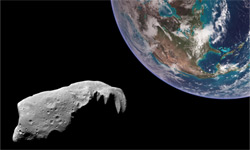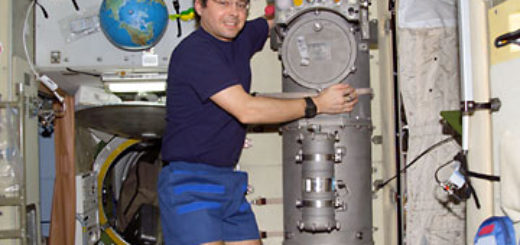10 Ways to Stop a Killer Asteroid

If you were being stalked by a killer, you would you try to stop him or her, right? Now let’s say your killer is a space rock shaped like an Idaho spud. What would you do about that? Interestingly enough, the odds of you being murdered at the hands of a madman are about one in 210 [source: Bailey]. The odds of being killed by a cosmic potato are a tad lower — about one in 200,000 to 700,000 over your lifetime, depending on who’s making the calculation [sources: Bailey, Plait]. But here’s the rub: No single person — not even someone as evil as Hitler — could wipe out the entire human race. An asteroid could. If a rock just 6 miles (10 kilometers) across struck our beautiful, blue world, it would be adiós muchachos for every last one of us [source: Plait].
So, stopping an asteroid from blindsiding Earth makes sense, but is it even possible? And if it’s possible, can we afford it? The answer to the first question might surprise you, because there are, in fact, many different ways to thwart a space rock. (No one ever said they were smart.) How much it might cost remains uncertain at best. Money, however, shouldn’t be the main concern when you’re talking about the survival of the human race. So let’s throw that question out the window and focus on the top 10 ways to stop a killer asteroid, no matter how crazy (or costly) they seem on paper.
Nuclear weapons may not be original, but they’re a known entity and, as a result, a logical choice if you need to blast a boulder to smithereens. This supermacho approach involves slamming a nuclear warhead into an approaching asteroid. There’s only one problem: A direct hit on a large object might only break it into several smaller pieces (remember “Deep Impact”?). A better option might be to detonate a warhead near the asteroid, letting heat from the explosion sear one side of the rock. As material vaporizes from its surface, the asteroid would accelerate in the opposite direction — just enough (fingers crossed) to steer it away from Earth.
If explosions aren’t your thing, but you still want to hit something, then you’ll appreciate another technique known as kinetic impactor deflection. The “kinetic” in this case refers to kinetic energy, which all moving objects have and the universe conserves. But we’re getting ahead of ourselves. Turn the page to learn how the behavior of billiard balls just might save our planet.
If you’ve ever played pool, then you know about kinetic energy, which is the energy possessed by any moving object. The kinetic energy of a struck cue ball is what gets transferred to other balls on the table. Astronomers believe the same principle could deflect an earthbound asteroid. In this case, the cue ball is an unmanned spacecraft similar to the probe used in NASA’s Deep Impact mission (not to be confused with the movie). The mass of the Deep Impact vessel was only 816 pounds (370 kilograms), but it was moving really, really fast — 5 miles (10 kilometers) per second [source: NASA].
Kinetic energy depends on both the mass and speed of an object, so a small object moving fast still has a lot of energy. When mission engineers slammed the Deep Impact probe into the surface of the Tempel 1 comet in 2005, it was slated to deliver 19 gigajoules of kinetic energy. That’s the equivalent of 4.8 tons of TNT, enough to shift the comet ever so slightly in its orbit [source: NASA].
Astronomers weren’t looking to alter Tempel 1’s trajectory, but they know now it could be done, should an asteroid or comet set its sights on Earth. Even with a success under their belt, scientists acknowledge the enormous challenge of such a mission. It’s sort of like hitting a speeding cannonball with a speeding bullet. One wrong move, and you could miss your target completely or hit it off-center, causing it to tumble or crack into pieces. In 2005, the European Space Agency came up with the Don Quijote concept to improve the odds of a kinetic impactor mission (see sidebar).
You might classify nuclear weapons or kinetic impactors as instant-gratification solutions because their success (or failure) would be immediately apparent. Many astronomers, however, prefer to take the long view when it comes to asteroid deflection.



 Creators of mankind
Creators of mankind Description of “Tall white aliens”
Description of “Tall white aliens” Where they came from?
Where they came from? About hostile civilizations
About hostile civilizations The war for the Earth
The war for the Earth “Tall white aliens” about eternal life
“Tall white aliens” about eternal life Video: “Nordic aliens”
Video: “Nordic aliens” Aliens
Aliens Alien encounters
Alien encounters The aliens base
The aliens base UFO
UFO Technology UFO
Technology UFO Underground civilization
Underground civilization Ancient alien artifacts
Ancient alien artifacts Military and UFO
Military and UFO Mysteries and hypotheses
Mysteries and hypotheses Scientific facts
Scientific facts


















